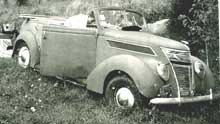Walter Chrysler and I have something in common. When he was 33 he bought a Locomobile and took it apart. I know the feeling: during the summer I turned nine I bought a Ford and did the same thing.
I knew I’d have a car sooner or later. I’d been consumed by them from my earliest memory, had learned to read from hubcaps and radiator ornaments. My moment came during the summer of 1953. A family friend had given me a copy of Ford at Fifty, the company’s commemorative book for the golden jubilee. It was a bit of puff publicity, a paean of praise, but it had lots of fascinating photos and some vignettes of folks with Fords. One concerned a farming family with an all-Ford fleet. One of the photos showed a youngster working on an old Ford truck. “I wish I had an old Ford to work on,” I mused.
It happened that my older cousin Ben had an extra one. He had recently traded up from his first car, a 1936 Ford convertible sedan, to a similar 1937 model. In the process he had acquired a parts car, but had taken all the parts he needed. He offered me the spare Ford for seven dollars. I didn’t hesitate. My dad towed it to our house, my uncle steering, with our Jeep. I was ecstatic, and spent the rest of the day daydreaming behind the wheel.
Thus started my Walter Chrysler period, learning by doing, taking my Ford apart. I read extensively, finding out how Fords were made, how they worked and how to fix them. Unlike Walter Chrysler, though, I didn’t put my car back together. Quite a few of the engine parts were missing, and not knowing the local junkyards I was at a loss to find them.
Ford built 4,378 convertible sedans in 1937, along with 3,723 phaetons without side windows. Whenever I see one I get nostalgic. I don’t feel any regret in failing to restore it – eventually I sold off many of its parts. The lessons it taught me, however, were invaluable. When I was given a complete but inoperative car, a ’47 Ford sedan, five years later, I was able to get it running within a week.

